Oracle Arena brings the noise for an NBA Finals worth screaming about

This story appeared in the June 8, 2015 issue of SPORTS ILLUSTRATED. To subscribe, click here.
In the first row behind the scorer's table, confetti at their feet and clamor in their ears, sits an only-in-Oakland extended family. Stanley Cox grew up in North Oakland, the son of a mother who worked four jobs and battled a drug habit while his father, a pimp, served time in jail. Cox's dad died when he was 12, of complications from AIDS, and he found refuge on local basketball courts. He sneaked into Oracle Arena—"The Coliseum," he clarifies. "To people here, it will always be the Coliseum"—by convincing ticket takers that he was lost and his parents were inside.
During warmups Cox hung out behind the Warriors' bench, where players were drawn to the boy with the round face and quick wit. Donyell Marshall let him stay at his house in the Oakland Hills. Latrell Sprewell and Joe Smith went to his games at Oakland Tech High School. Cox was a point guard, but his cadence was quicker than his crossover, and he tongue-lashed all challengers in freestyle rap battles.
In 2003, Cox released his first CD, under the name Mistah F.A.B., and soon he was known as "the crown prince" of the East Bay's fabled hip-hop scene. The flashy rhyme master blossomed into a successful songwriter and producer, collaborating with Snoop Dogg, Too $hort and Chris Brown. In '07 the Warriors reached the playoffs for the first time since F.A.B. was in elementary school, and he splurged on front-row tickets behind the scorer's table. He snagged a pair on StubHub in Section 1 Row 1A for himself and his mom for a game against Dallas. The seller was the owner of a major contract furniture company named Jeff Tuttle, who had six season tickets in the row and couldn't use them all.
F.A.B. and Tuttle seemed to have little in common—one black, one white; one young, one middle-aged; one bejeweled, one bespectacled—except their passion for the Warriors, which was more than enough to foster a friendship. With the Mavericks in town, F.A.B. serenaded owner Mark Cuban. "This is the one thing," he crowed, "that you can't buy!" Golden State won the series, and Tuttle invited F.A.B. to permanently join his block. They cheered together when the Warriors unveiled Steph Curry in 2009 and grieved together when F.A.B.'s mom, Desire Jeffrey, died of cancer in '10. Both of F.A.B.'s parents were gone. Tuttle, 58, became the closest approximation. "He calls me dad," Tuttle says, "and I call him son."
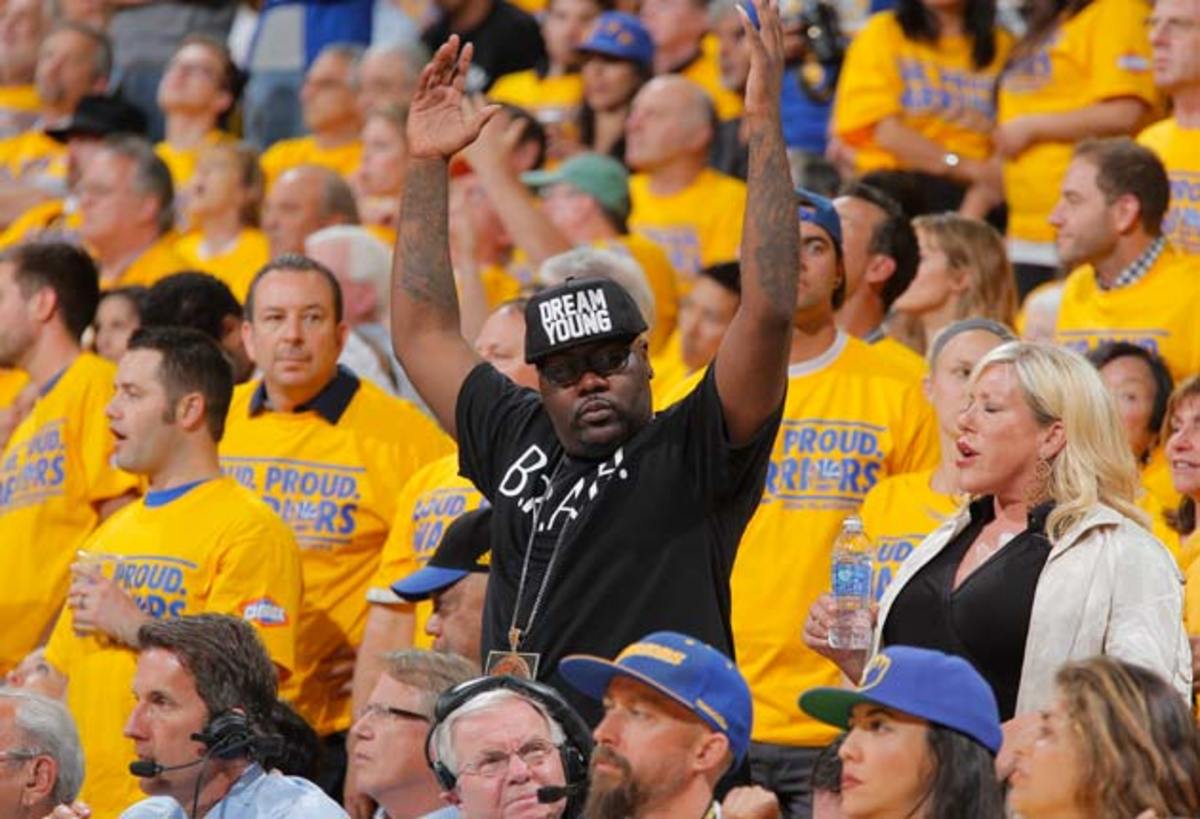
They talk on off days, about business and fatherhood, but at tip they turn their attention to the floor. "What did you do to O.J. Mayo?" Tuttle asked Grizzlies guard Tony Allen in the Western Conference semifinals. Allen, reminded of a notorious skirmish on a team plane, shot back: "Same thing I'm going to do to you." Tuttle is egged on by the eclectic crew he has assembled in 1/1A: friends, clients, his son, Nick—and a 33-year-old wordsmith with gold-spiked Christian Louboutin boots. After the Warriors beat the Rockets in Game 2 of the Western Conference finals, Mistah F.A.B. waded through confetti the same color as his boots, replaying the final sequence: a dash by Houston's James Harden, a trap by Curry and Klay Thompson, a buzzer-beating strip and a migraine-inducing roar. F.A.B. gazed at his daughter, six-year-old Liberty, swaying by her seat. He was reminded of his mom. He wondered if she was watching.
"There's something about this place," F.A.B. cooed. "Maybe it's old, maybe it's uncomfortable, but it's our piece of heaven. It's Oakland. It has a soul, a vibe. You think crowds don't matter? You've never been to the Coliseum, baby."
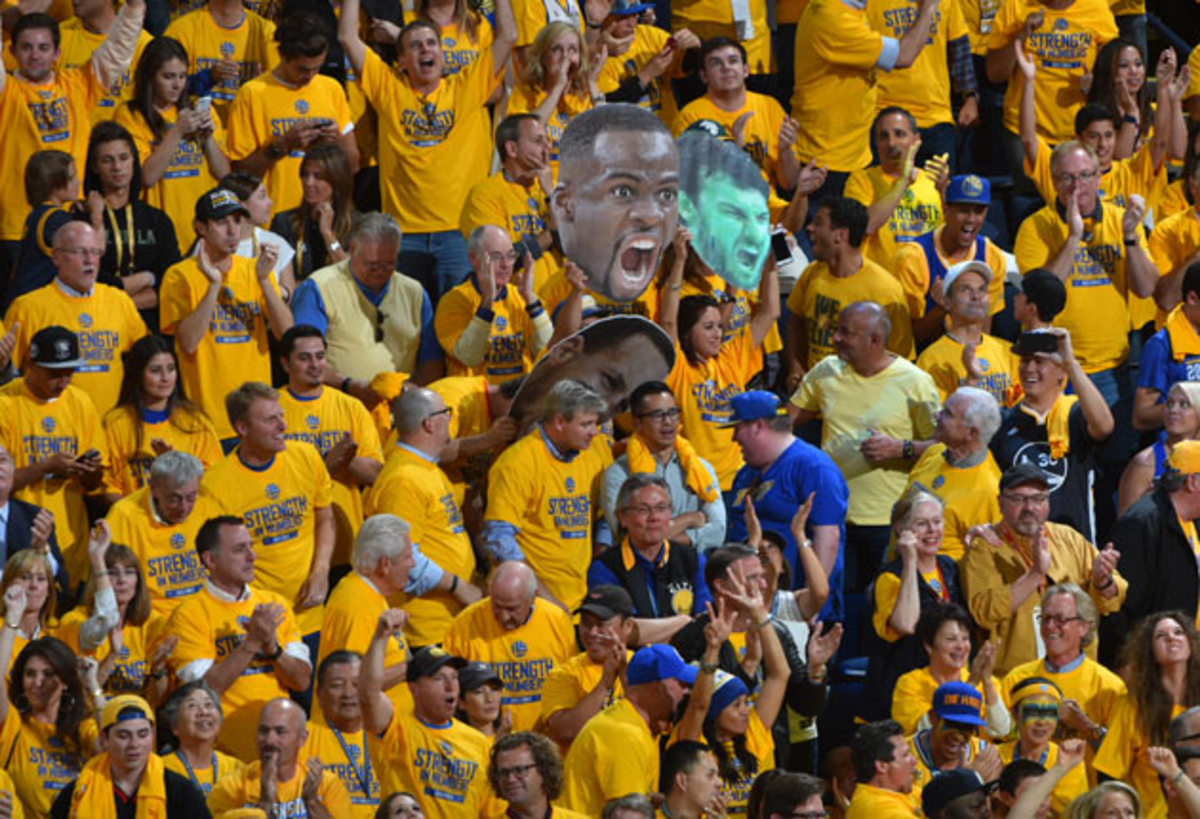
Oakland-Alameda County Coliseum Arena was built in 1966, a hockey puck of a structure off Interstate 880, next door to the football stadium. The San Francisco Warriors, as they were then known, did not move in immediately. Their primary home remained the Cow Palace, in Daly City, with occasional dates at the Coliseum. By 1971 the Warriors had the lowest attendance in the league, according to the San Francisco Chronicle, and owner Franklin Mieuli was desperate to improve it. He changed the team's name to the Golden State Warriors and reportedly devised a scheme to split the home schedule between an auditorium in Oakland and the San Diego International Sports Arena, eight hours south.
My Town, My Team: Warriors' return to the NBA Finals too sweet not to savor
The odd plan was never realized because the Warriors found a full-time residence at the Coliseum, though they did host six games in San Diego in 1971-72. "The Coliseum was just a big, gray cement building," says Jim Barnett, a Golden State guard in the early '70s and now a television analyst for the team. "Fan support was not significant yet." Much is made of the Warriors' crowds, loyal through four lean decades, but they still ranked 25th in attendance in 2001, 24th in '02 and 21st in '03. "There were a lot of nights I was the only one making any noise," says John Goldstein, a season-ticket holder who sits above the tunnel leading to the Warriors' locker room. Beneath Goldstein is a blue plexiglass PS4 billboard, which he used to bang so violently that Nets point guard Jarrett Jack once asked him to pipe down, albeit in more colorful language.
Oracle Arena, as it was renamed in October 2006, did not cause any punctured eardrums until that shocking playoff run the following spring. Stephen Jackson drilled seven three-pointers in Game 6 against Dallas, Baron Davis vaulted Andrei Kirilenko in Game 3 against Utah, and a large but latent base sprung to life. "There was always hope here," recalls former Warriors center Adonal Foyle, "but it turned into belief." Suddenly, Golden State was the new Sacramento, minus the cowbells. "That was the loudest I ever heard," remembers former Mavs guard Jason Terry, now with the Rockets. The Warriors promptly shot into the top 10 for attendance, and when they returned to the playoffs in '13, ESPN's decibel meter showed readings of 110—higher than a jet flyover at 1,000 feet. "It's O.K.," says Jimmy Goldstein, the NBA's courtside fixture, who attends about 35 playoff games a year in his exotic leather. "My hearing is already shot from nightclubs and basketball arenas."
NBA vets typically cite Oklahoma City, Utah and Portland as other deafening locales, but those crowds are as monochromatic as playoff T-shirts. Golden State, like Memphis, is a diverse cauldron of chaos. "It's Oakland," says John Goldstein. "You never know who you're going to get." The audience is responsible for the racket, but the acoustics don't hurt, either. Oracle's low roof and concrete surfaces, hallmarks of arena design in the 1960s, reflect sound waves like ricocheting rubber balls. "Sporting events can be made louder or softer by architectural choices," says University of California psychology professor Ervin Hafter, who directs the Hafter Auditory Perception Lab and conducts a weekly auditory colloquium called The Ear Club. He also follows the Warriors. "[Oracle] is a closed box with lots of hard, reverberant surfaces with really nothing to absorb the sound except the clothed bodies of the attendees."
• MORE NBA: SI magazine's best NBA stories from 2014-15 season
There are stretches, when Curry is leading breaks and Thompson is splashing threes and Draymond Green is taking charges, that visiting teams cannot hear play calls or whistles. In the first round Pelicans coach Monty Williams suggested that Golden State's full-throated denizens were breaking NBA rules, and he had a point. The league does not allow its buildings to exceed a certain decibel limit, but that sound barrier exists to cap artificial noise. Oracle's outpouring is largely organic, aided by the jumbotron's pleas to raise the volume. The bedlam is legal. The question is whether it makes a difference.
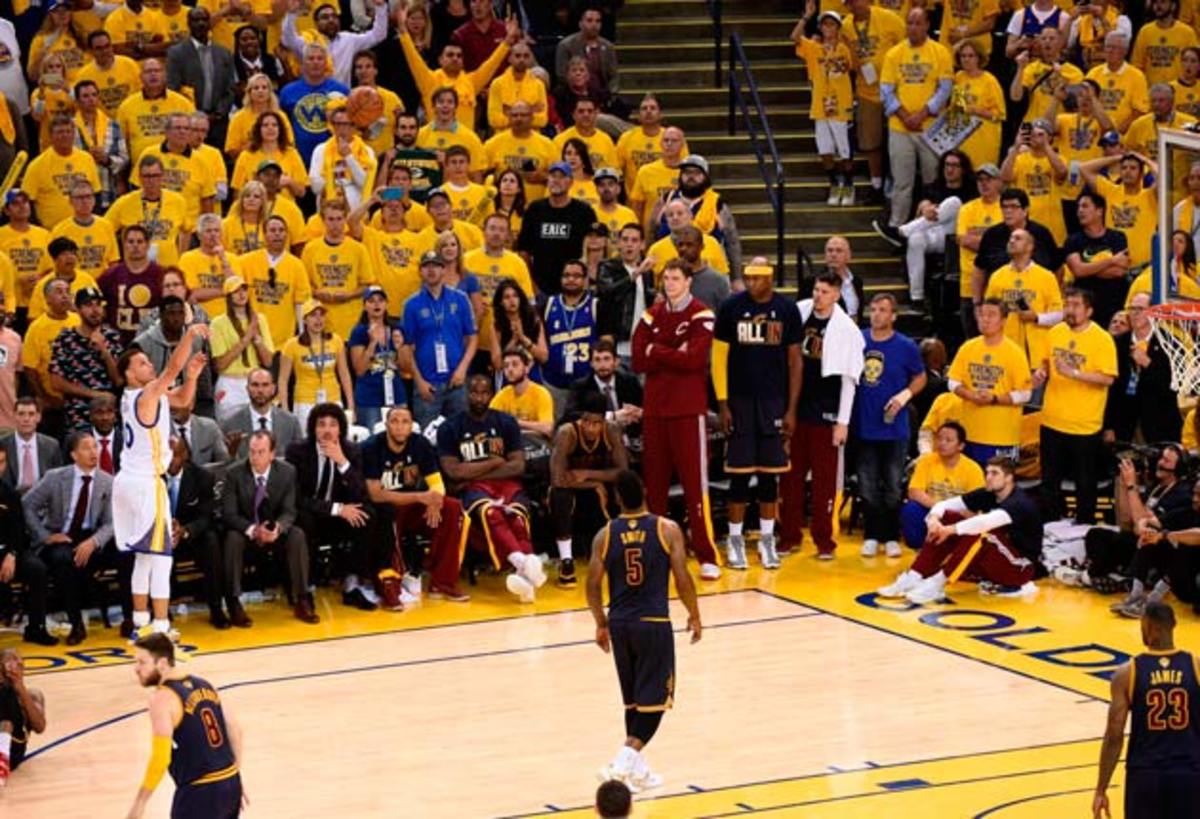
The Warriors had the best offense, best defense and best record in the NBA this season. They excelled everywhere, but especially at Oracle Arena, where they went 39-2. Measuring the noise at Oracle is simple—a microphone on a silver tripod sits atop the scorer's table, attached to a computer—but determining the effect of the noise is not. Is this sixth man more meaningful than, say, the actual sixth man? Or did the Warriors dominate at home because they were sleeping in their own beds and shooting on their own rims? The Cavaliers, who don't exactly play in a library themselves at Quicken Loans Arena, are about to get a clue. "If you're an opposing team, and you're not used to the noise here, you can get rattled," says Golden State forward Harrison Barnes. "We have those dagger plays—those threes, those crazy shots, those four-point plays—and it gets loud and rowdy. It's hard to take yourself out of that and think of the next possession."
In the Western Conference finals the Warriors noticed that the Rockets ran a play called Double X Double, which they struggled to execute because they could not hear the point guard's voice. "Sometimes you have to lip read," says Houston player-development coach Greg Buckner. But basketball is not football. Signals are not as complex, nor as carefully concealed, and most are delivered through hand gestures. "We don't audible," adds Golden State associate head coach Alvin Gentry, and Curry does not hush the throng the way Peyton Manning does. In football, noise provides a tactical impediment, while in basketball it is more psychological.
"I've seen a lot more mistakes happen in the midst of noise," Terry says. "Players missing shots they usually make, blowing assignments they usually remember. The noise is a reminder that something important is happening here right now, and some guys don't respond to intense pressure." Others try too hard to respond. "What gets you is when you make some big individual effort to [try to] quiet the crowd by yourself," says Rockets forward Josh Smith. "That's when the run really gets going."
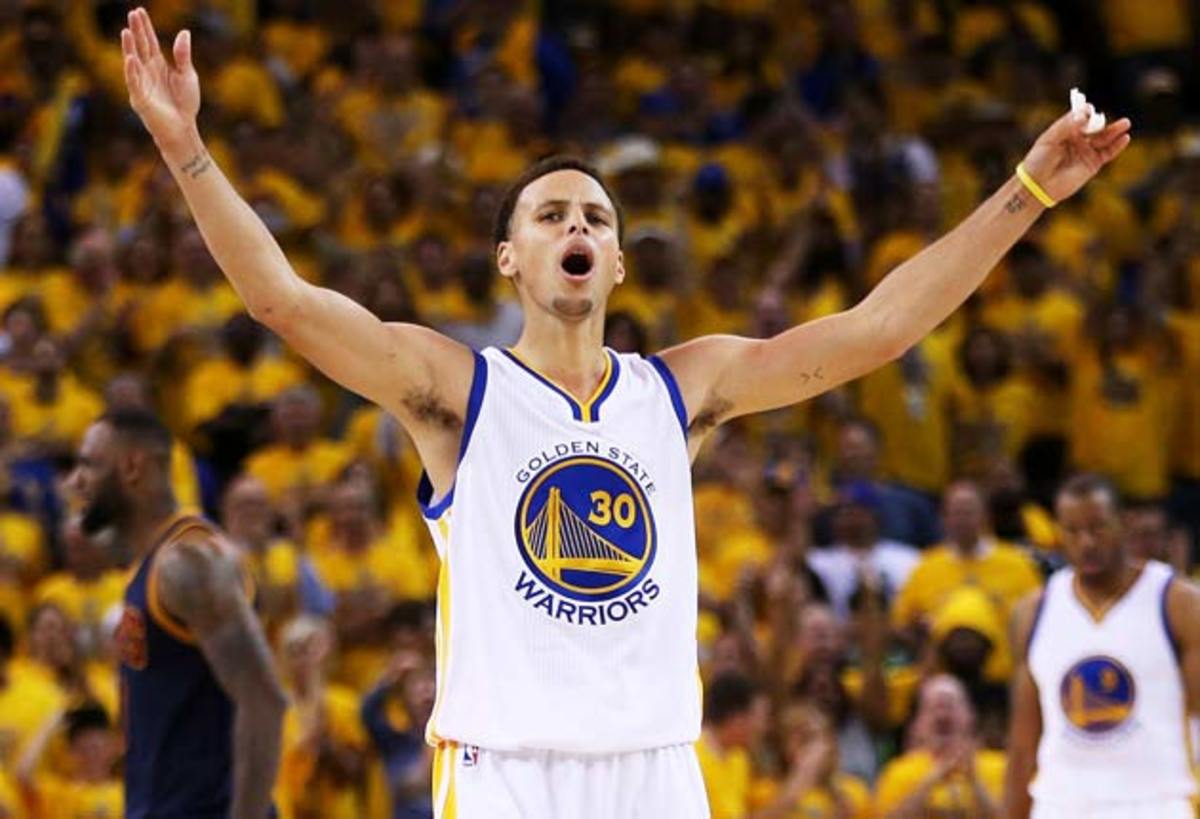
Noise has been used as a weapon since Joshua's army blew horns at Jericho. The Aztecs sounded a "death whistle" before battle. Santa Anna's soldiers played a bugle as they stormed the Alamo. British agents piped hissing sounds into the cells of IRA terrorists. American troops blasted heavy metal at Panamanian dictator Manuel Noriega. Sound torture is proven to work on hostages but not necessarily on professional basketball players. In the book Scorecasting, University of Chicago behavioral economist Tobias Moskowitz and SI executive editor L. Jon Wertheim calculated the home/road splits of free throw percentages, one category theoretically unaffected by any variable except crowd noise. They concluded that, across two decades, the cumulative free throw percentage of home teams was 75.9%. The percentage for visitors? 75.9%. The numbers did not fluctuate in close, late-game situations either. "Evidence of the crowd significantly affecting the performance of NBA players is hard to find," Moskowitz and Wertheim wrote.
The home team, after all, is subjected to the same decibel count as the guests for most of the game. Noise is noise, no matter where it's coming from. "But it's not about the noise itself," says William Parham, a professor at Loyola Marymount and a sports psychologist who has consulted with many pro athletes, particularly in the NBA. "It's about one's interpretation of the noise. If you're Golden State, and you hear that noise, you know that you're on to something and people are behind you. If you're the other team, the same noise is a signal: 'Uh-oh, things aren't going well, the sixth man is alive.'" Whatever doubt already exists in the mind—whatever noise might be swirling around—is amplified.
In 2011, Central Florida professors James L. Szalma and Peter Hancock wrote a meta-analysis for Psychological Bulletin about the effects of noise on human performance. "It isn't just that noise distracts," Szalma says. "It consumes your mental capacities in a way that depletes them, so you have less available for your primary task. We found that human voices are actually the most disruptive kind of noise, more than white noise or industrial noise. So if you're thinking about your next move, and you hear someone yelling from the stands, that sound can disrupt your thought process—unless you've developed coping skills to ignore it."
Since players can't wear their $300 headphones on the court, they have to do their own noise-canceling. "I try to put a whole bunch of other stuff in my mind," says Smith. "Focus on everything but the atmosphere: the next play, the next pick-and-roll, all the details." The Warriors, on the other hand, marinate in mayhem. This is a team that practices to a playlist with Tupac and Drake, Aerosmith and Michael Jackson. They haven't worked a full day at Oracle unless they leave with a throbbing headache. "Why would we block it out?" asks center Festus Ezeli. "We love it."
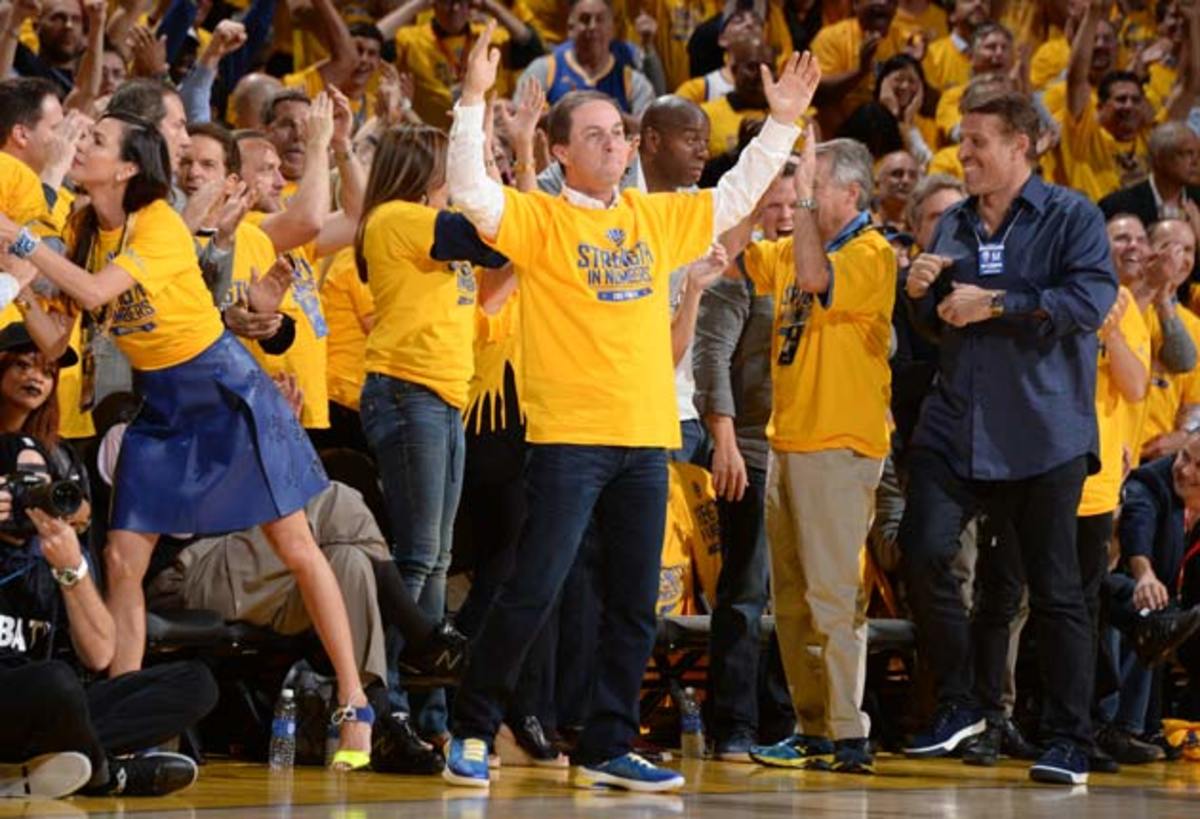
On May 21, at the Warriors' headquarters in downtown Oakland, majority owner Joe Lacob and team president Rick Welts met with architects for 2½ hours. They discussed, among other topics, how to bottle the ruckus of Oracle Arena and transport it 16 miles west. The Warriors have purchased 12 acres in the Mission Bay neighborhood of San Francisco, where they plan to build a privately financed arena. They are currently finalizing their Environmental Impact Report and, according to Welts, are hoping to start construction by Jan. 1.
The new joint will be sleek and modern, just fancy enough to possibly drive another wedge between Oakland and San Francisco. The A's and the Raiders are Oakland's teams. The 49ers and the Giants are San Francisco's. The Warriors belong to both. Hipsters and hustlers, techies and venture capitalists, they're all at Oracle. Anxiety abounds, even within the courtside club sponsored by BMW, that Oakland constituents will be lost in the move, and that raucous atmosphere will suffer as a result. "The Oakland side brings the ferocity," says Mike Sherman, who sits in Tuttle's row. "It will be more corporate, more international." "More Silicon Valley," Mistah F.A.B. adds. "More comfortable."
Stephen Curry's next stage: MVP has Warriors closing in on the NBA Finals
You can't ask anybody about the Warriors' new arena without hearing about the 49ers' new stadium, a $1.2 billion Taj Mahal in Santa Clara with 165 luxury suites, 8,500 club seats, a 20,000-square-foot museum, a steak house by celebrity chef Michael Mina and a home crowd that seems sedated by all the amenities. "Levi's Stadium is a palace," says Joe Azzolina, a former Warriors executive who was in charge of game presentation. "The clubs are huge. The facilities are palatial. I've never seen anything like it in a sporting venue. But some diehards will still tell you they want to be back at Candlestick with the crazy parking and long lines."
The Warriors heed those concerns. "The first, middle and last thing we talk about is how you preserve the fan environment we have here," Welts says. "What can we do to make sure quality of the sound there is the same as quality of the sound here?" The Machete Group, which advised Nets owner Mikhail Prokhorov on the Barclays Center project in Brooklyn, created a model of Oracle Arena in order to study the building's acoustic properties. They found that the biggest factor behind the noise, besides the impassioned gallery, was the relatively small volume of the bowl. "Newer buildings are taller," says David Carlock, principal of the Machete Group. To keep the ceiling low, the Warriors will incorporate only one rung of suites, compared with two at Oracle and three at Staples Center in Los Angeles. Capacity will shrink, from 19,500 to 18,000, and Welts insists every seat will be as close or closer to the floor. Who occupies them is yet to be determined, but according to Welts the current season-ticket base is split almost 50-50 between the East Bay and San Francisco, and with the Warriors in the Finals for the first time in 40 years, no one is looking to bail. "I don't see a reason why it's going to fundamentally change," Welts says. "There's nothing about this that isn't possible to replicate."
The Warriors dark-horse spirit was bound to evolve, anyway, with the league's best record and the MVP. As Grant Brisbee wrote for SB Nation, "[T]his is a franchise at the end of a transition from spunky underdog to shiny favorite, and they're moving to the land of shiny favorites." Of course two years still remain until the move, and two weeks until the coronation. For now the Warriors get to be all things: Oakland and San Francisco, upstart and establishment, erstwhile doormat and potential dynasty. A thousand architects couldn't reproduce such a moment in time. The sound it generates will be something for The Ear Club to analyze next fall: LeBron, Steph and a long-suffering congregation raising the short roof.
Some will be bothered. Others will be boosted. It depends on the performer. "You get energy, elation," says Mistah F.A.B., who has played at Oracle himself. "It's the feeling that, 'This is all for me!' If you don't faint, it can lift you up, to a place where you can't be stopped."
